| کد مقاله | کد نشریه | سال انتشار | مقاله انگلیسی | نسخه تمام متن |
|---|---|---|---|---|
| 5562457 | 1562598 | 2017 | 9 صفحه PDF | دانلود رایگان |

- Reactive quinonimine metabolites of AQ and DEAQ are inactivated by GSTs and NQO1.
- Variability of GST levels results in interindividual differences in hepatic detoxication.
- High rates of bioactivation combined with slow detoxication may increase risk for AQ-induced toxicity.
Amodiaquine (AQ), an antimalarial drug, widely prescribed in endemic areas of Africa and Asia, is used in combination with artesunate as recommended by the WHO. However, due to its idiosyncratic hepatotoxicity and agranulocytosis, the therapeutic use has been discontinued in most countries. Oxidative bioactivation to protein-reactive quinonimines (QIs) by hepatic cytochrome P450s and myeloperoxidase (MPO) have been suggested to be important mechanisms underlying AQ idiosyncratic toxicity. However, the inactivation of the reactive QIs by detoxifying enzymes such as human glutathione S-transferases (GSTs) and NAD(P)H:quinone oxidoreducatase 1 (NQO1) has not been characterized yet. In the present study, the activities of 15 recombinant human GSTs and NQO1 in the inactivation of reactive QIs of AQ and its pharmacological active metabolite, N-desethylamodiaquine (DEAQ) were investigated. The results showed that GSTP1-1, GSTA4-4, GSTM4-4, GSTM2-2 and GSTA2-2 (activity in decreasing order) were active isoforms in catalyzing GSH conjugation of reactive QIs of AQ and DEAQ. Additionally, NQO1 was shown to inactivate these QIs by reduction. Simulation of the variability of cytosolic GST-activity based on the hepatic GST contents from 22 liver donors, showed a large variation in cytosolic inactivation of QIs by GSH, especially at a reduced GSH-concentration. In conclusion, the present study demonstrates that a low hepatic expression of the active GSTs and NQO1 may increase the susceptibility of patients to AQ idiosyncratic hepatotoxicity.
Journal: Toxicology Letters - Volume 275, 5 June 2017, Pages 83-91